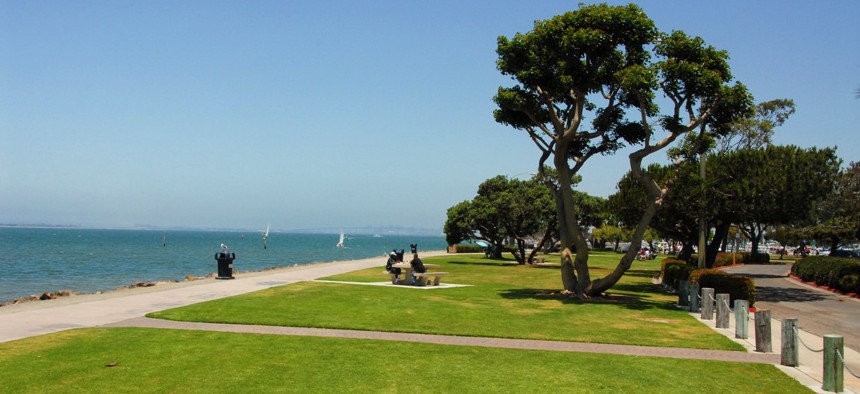Smart City Development Is a Marathon, Not a Sprint

Chula Vista Bayfront Park Port of San Diego / Flickr.com

Connecting state and local government leaders
Chula Vista took a decade to ensure the West Coast’s largest waterfront smart development is built with sustainability in mind.
Chula Vista, California, began drawing up its Smart City Roadmap a little over a year ago, but in some ways the municipality’s plan for sustainable smart infrastructure is 10 years in the making.
The roadmap’s framework is based on the Chula Vista Bayfront master plan, put together during the past decade by the city and its neighbor, the Port of San Diego, to guide the transformation of the West Coast’s largest waterfront development at 535 acres.

The City of Allure wants to pilot as many smart technologies as possible, learning from data to scale whatever proves successful citywide.
“Part of it is really identifying what is important and what are the priorities of the city,” Dennis Gakunga, Chula Vista’s chief sustainability officer, told Route Fifty in an interview. “We see this as an investment, and the more planning there is on the front end, the more payoff there is on the back end.”
A coalition of stakeholders, largely environmentalists, formed while creating the master plan, and both the city and port agreed to sustainability targets.
For instance, the development is expected to use a minimum of 50 percent less energy annually than the status quo through methods such as generating renewable energy on site. Buildings within the development must perform 15 percent better than those adhering to California’s Building Energy Efficiency Standards.
The concept has since been expanded to include things like water efficiency, so the port and city engaged a data consultant to advise their roadmap. Overland Park, Kansas-based engineering and construction company Black & Veatch has spent the last year analyzing the bayfront and establishing baselines in the areas of energy management, network connectivity and foundational smart infrastructure.
“Our role is to break down silos and bring [partners] all together,” said Steph Stoppenhagen, smart cities business development manager at Black & Veatch. “I don’t think cities do anything unless they have the right partnerships. A lot of companies just want their name on something.”
That’s exactly what Chula Vista is working to avoid with its roadmap.
Cities too caught up in the idea of rolling out smart technologies quickly often fail to ensure the projects are sustainable, and that includes funding. Paul Stith, an energy adviser with Black & Veatch, calls the phenomenon “pilot fatigue.”
“New relationships with utilities and transportation are necessary where they were resisted before,” he said.
Chula Vista partnered with the port because it manages the San Diego Bay’s tidelines, but it’s also working with major local academic institutions, nonprofits like regional member organization Cleantech San Diego and the broader community for financing and accelerated deployment of the latest clean technologies.
Part of Black & Veatch’s analysis involves gauging the return on investment of specific pilots and where to find additional operational savings.
The size and uniqueness of the project, as well as its commitment to sustainability targets, has attracted national and international attention of national and international investors, Gakunga said, and grants are another piece of the roadmap’s budget.
Smart city challenges generate excitement because of their grand visions and big payouts, Stoppenhagen said, but they’re one-time events. And some infrastructure can only be retrofitted once.
Long-range strategic planning allows Chula Vista to pilot technologies like San Diego-based Qualcomm’s adaptive street lighting with confidence. Upgraded poles downtown will be used to test the streetlights’ traffic camera and smart parking functions as well.
Piloting smart infrastructure in a live environment generates datasets that help realize more permanent, future solutions. A side program monitoring demo successes and lessons learned is critical to the sustainable smart city, Stoppenhagen said.
Black & Veatch helped Chula Vista establish an impact rating system that lets the city score potential pilots based on criteria like operational efficiencies, economic development and climate action planning to help officials set priorities. The data consultant has also assisted Chula Vista in avoiding proprietary vendors that make it hard to switch products or services without incurring hefty additional costs
The California Coastal Commission unanimously approved the project in 2012, but officials want community buy-in as well.
“If the city doesn’t help citizens and make them happy, then it’s not going to get anywhere,” Stoppenhagen said.
That means educating residents in order to meet goals, she added, like making a certain amount of roofs solar by offering workshops explaining photovoltaic system benefits.
Historically, Chula Vista has seen uneven development from a geographic standpoint—most of it occurring in the eastern part of the city. To ensure smart infrastructure benefits everyone, it must reach disadvantaged communities.
The city is seven miles north of the world’s busiest border crossing and strives for a binational development that also serves the population of Mexico in sparking smart city network innovation.
“We need to start thinking about demographics, not just in terms of diversity but age, and preparing them for the new economy,” Gakunga said.
Roadmap negotiations are wrapping up, after which there will be an estimated 18-month design process.
The following first buildout phase will take an anticipated 30 months—including a signature park, convention center, hotels, commercial, and retail—finishing up in 2021 ideally.
“Not a lot of cities have this ability,” Gakunga said.
Dave Nyczepir is a News Editor at Government Executive's Route Fifty and is based in Washington D.C.

NEXT STORY: Can You Go Home Again? Some Older Retirees Say Yes





